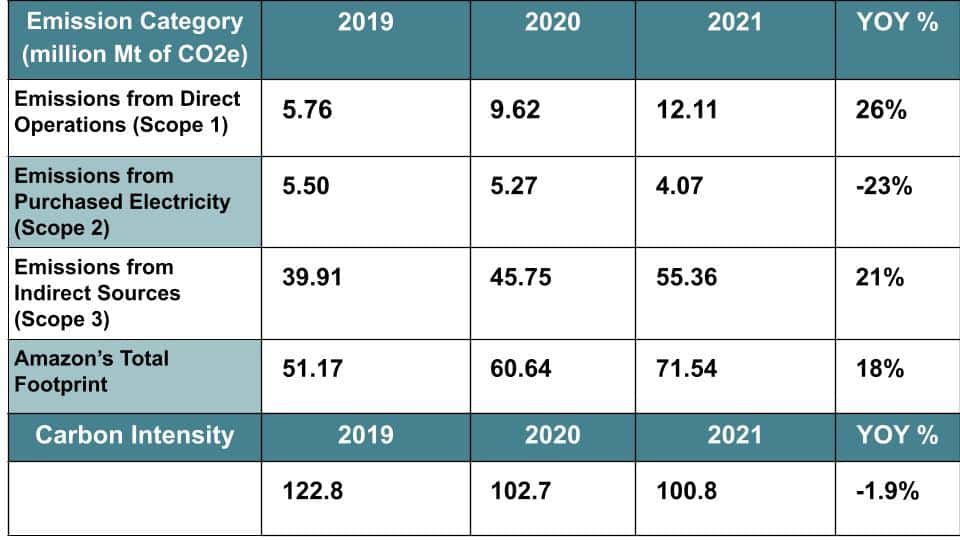Amazon’s carbon footprint grew 18% in 2021 and up 40% since 2019. The firm’s rapid growth overcame its efforts to cut its emissions and faces four net zero challenges.
The world’s largest online retailer emitted a total of 71 million metric tons of CO2 equivalent last year as revealed in its latest sustainability report.
Despite this, the giant retailer’s carbon intensity was down by 1.9%, a 3rd year in a row as seen in the table below. It represents the amount of the firm’s total emissions over its gross merchandise sales.
The falling carbon intensity shows that Amazon is becoming more efficient in its operations. That’s in terms of running its offices, warehouses, data centers, and shipping its products worldwide.
Amazon’s Net Zero Carbon Footprint
Amazon accounts its carbon footprint by including emissions from:
- its own offices and data centers,
- purchased electricity,
- tailpipe emissions from delivery partners, and
- the manufacturing of Amazon-branded products
The Seattle firm committed to achieve net zero emissions by 2040, 10 years ahead of the Paris Agreement.
The company co-founded The Climate Pledge in 2019 as part of its net zero commitment. The initiative’s main goal is to bring companies together to speed up climate action. It will enable business leaders solve the challenges of decarbonizing the economy.
Leading the 300+ member companies of the pledge, Amazon commits to be the champion in three areas of climate actions:
- Regular reporting of emissions
- Eliminating carbon via various decarbonization strategies
- Using credible carbon offsets
Amazon is implementing different strategies to cut its carbon footprint. These include electric vehicle use, operational innovations, efficiency improvements, and renewable energy.
It also aims to buy carbon credits generated by projects that remove carbon.
While the company is taking big strides in cutting its emissions, its sudden growth presents key challenges towards net zero.
Amazon stated in its report:
“The challenges we collectively face on the path to net-zero carbon are considerable… Many new technologies are showing promise in their ability to reduce carbon emissions, but may still need significant development.”
4 Key Net Zero Challenges of Amazon
100% Renewable Energy by 2025
In 2021, Amazon achieved 85% renewable energy across its operations. With this pace, the firm is confident that it’s on a path to reach 100% by 2025.
Research found that moving on-premises computing workloads to AWS can reduce carbon footprint by about 80%. This is in comparison to the surveyed enterprise data centers. The figure can go up if AWS will work with 100% renewable energy.
- AWS’ infrastructure is 3.6x more energy efficient than the median of surveyed U.S. enterprise data centers. Plus, it’s 5x more energy efficient than the average European enterprise data center.
More-Sustainable Transportation Infrastructure
Amazon plans to make half of its shipments net zero carbon by 2030 by creating a worldwide fleet of zero-emission vehicles.
Right now, the vehicles and charging infrastructure don’t exist at the scale needed. But the firm ordered over 100,000 EVs from different carmakers.
Amazon is also exploring green hydrogen technologies and invested in hydrogen firms (EH2 and Sunfire). It’s also at the heart of industry initiatives and partnerships including:
- the Cargo Owners for Zero Emission Vessels network (coZEV),
- the First Movers Coalition,
- the Sustainable Aviation Buyers Alliance Aviators Group (SABA), and
- the Clean Energy Demand Initiative.
More-Sustainable Buildings
Amazon is reducing the carbon footprint of its buildings by using CarbonCure’s systems and Brimstone Energy cement in new constructions. These include Amazon’s second headquarters in Virginia (HQ2) – a model for sustainable construction.
- HQ2 operations are electrified, eliminating the use of fossil fuels for building systems and food service.
The firm is also innovating construction techniques to power fulfillment centers with solar. As of 2021, 115 of its global fulfillment facilities have rooftop solar installations.
Also, in building its AWS data centers, Amazon requires concrete with a 20% reduction in carbon compared with standard concrete for new U.S. data centers.
Likewise, the company is shifting to steel made in electric-arc furnaces that use scrap steel and renewable energy. In 2021, 6 AWS data centers were built with steel made that way.
Decarbonizing the Supply Chain
Amazon uses an extensive supply chain to deliver goods and services to customers. Its carbon accounting process takes into consideration all three scopes of emissions.
To achieve net zero carbon footprint by 2040, Amazon has to understand, measure, and report emissions data. Transparency is critical in net zero reporting, especially involving Scope 3 or supply chain emissions.
Amazon partners with and supports the We Mean Business Coalition’s Climate Hub. It’s a global initiative that gives small and medium-sized enterprises, like those in Amazon’s supply chain, free tools and resources to measure and report their emissions.
The company will continue to work with partners both in the public and private sectors to advance climate solutions. To the innovators, scientists, builders, and entrepreneurs, Amazon say that:
“Our door is open. We all need to decarbonize. The work may not make the headlines or bring immediate rewards, but a challenge like this will never be resolved overnight. These are the hard steps that need to be taken.”


